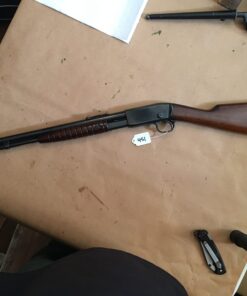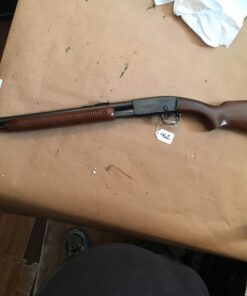Lee Enfield, S.M.L.E. Mk III, .303 cal., Bolt Action Rifle
$1,500.00
S.M.L.E. MK III
1 in stock
History
The Lee–Enfield is a bolt-action, magazine-fed, repeating rifle that served as the main firearm used by the military forces of the British Empire and Commonwealth during the first half of the 20th century. It was the British Army‘s standard rifle from its official adoption in 1895 until 1957. The WWI versions are often referred to as the “SMLE”, which is short for the common “Short, Magazine, Lee–Enfield” variant.
A redesign of the Lee–Metford (adopted by the British Army in 1888), the Lee–Enfield superseded the earlier Martini–Henry, Martini–Enfield, and Lee–Metford rifles. It featured a ten-round box magazine which was loaded with the .303 British cartridge manually from the top, either one round at a time or by means of five-round chargers. The Lee–Enfield was the standard issue weapon to rifle companies of the British Army and other Commonwealth nations in both the First and Second World Wars (these Commonwealth nations included Australia, New Zealand, Canada, India and South Africa, among others). As a standard-issue infantry rifle, it is still found in service in the armed forces of some Commonwealth nations, notably with the Bangladesh Police, which makes it the second longest-serving military bolt-action rifle still in official service, after the Mosin–Nagant (Mosin-Nagant receivers are used in the Finnish 7.62 Tkiv 85). Total production of all Lee–Enfields is estimated at over 17 million rifles.
The best-known Lee–Enfield rifle, the SMLE Mk III, was introduced on 26 January 1907, along with a Pattern 1907 bayonet and featured a simplified rear sight arrangement and a fixed, rather than a bolt-head-mounted sliding, charger guide. The design of the handguards and the magazine were also improved and the chamber was adapted to fire the new Mk VII High Velocity spitzer .303 ammunition. Many early models, Magazine Lee–Enfield (MLE), Magazine Lee–Metford (MLM) and SMLE, were rebuilt to the Mk III standard. These are called Mk IV Cond., with various asterisks denoting subtypes.
During the First World War, the SMLE Mk III was found to be too complicated to manufacture and demand outstripped supply; in late 1915 the Mk III* was introduced, which incorporated several changes, the most prominent of which were the deletion of the magazine cut-off mechanism, which when engaged permits the feeding and extraction of single cartridges only while keeping the cartridges in the magazine in reserve and the long-range volley sights. The windage adjustment of the rear sight was also dispensed with, and the cocking piece was changed from a round knob to a serrated slab. Rifles with some or all of these features present are found, as the changes were implemented at different times in different factories and as stocks of parts were depleted. The magazine cut-off was reinstated after the First World War ended and not entirely dispensed with in manufacturing until 1933 and some rifles with cut-offs remained into the 1960s.
The SMLE Mk III* (renamed Rifle No.1 Mk III* in 1926) saw extensive service throughout the Second World War, especially in the North African, Italian, Pacific and Burmese theaters in the hands of British and Commonwealth forces. Australia and India retained and manufactured the SMLE Mk III* as their standard rifle during the conflict and the rifle remained in Australian military service through the Korean War, until it was replaced by the L1A1 SLR in the late 1950s. The Lithgow Small Arms Factory finally ceased production of the SMLE Mk III* in 1953.
[edit]This One
This Lee Enfield is graded in Very Good condition. For being as old as it is, it looks great.
[edit]Sales Tax
Oklahoma Sales Tax will be added to the sale price of this firearm and any S&H charges will be charged to the buyer.
Shipping Info
All shipped firearms must be shipped to a currently registered Federal Firearms Licensee (FFL) holder. Please contact your local FFL and have them send us a copy of their FFL to [email protected]. Steps to purchase a firearm online are here
Be the first to review “Lee Enfield, S.M.L.E. Mk III, .303 cal., Bolt Action Rifle” Cancel reply
You must be logged in to post a review.









Reviews
There are no reviews yet.